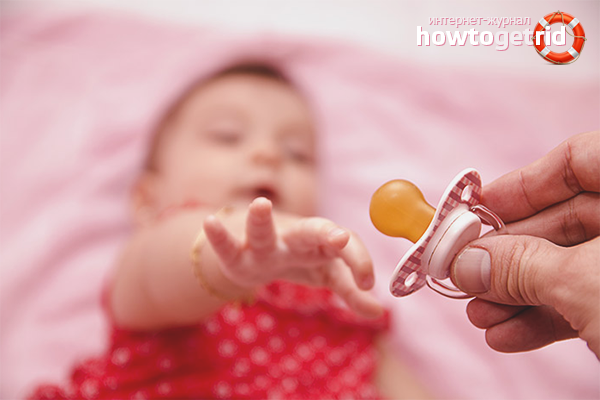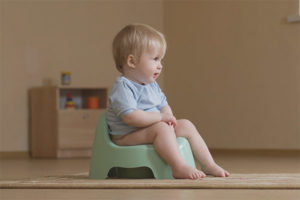The content of the article
It is recommended to teach babies to dummies both breast-fed infants and babies eating mixtures. The nipple, contrary to myths, does not contribute to the formation of a malocclusion. Children with dummies begin to talk no later than peers who have never had such an accessory. The only minus is that some kids for a long time wean from their "toys", but first they need to be accustomed to it.
At what age to give a pacifier
Introducing infants with a latex alternative to their mother’s breasts should be from 4-6 weeks. During this period, the child begins to understand that there are two types of sucking. The first variety is needed to get enough when the baby is hungry, and the second helps him calm down.
You can not give a pacifier from the first days of birth if the mother has problems with lactation or the baby does not properly capture the breast, injuring the nipple and the skin around it. Dummies are recommended for babies who were born prematurely, but the pediatrician should control the process of the child getting used to the new accessory.
You can teach a baby to a nipple in the second or fourth month, when the teeth begin to cut. A rubber toy is ideal to nibble and grind gums on it. If the baby has not gotten used to the dummy before 8-12 months, then it is better to abandon this venture, because very soon he will have more interesting activities and habits.
Choose a good accessory
When choosing a dummy, young parents, especially dads, often do not pay attention to details such as age limits. There are accessories for babies from the first days of life to 3 months. They are small and compactly placed in the mouth of a newborn. Dummies from 4 to 6 months are slightly larger, because the child himself is constantly growing. And the largest are nipples for children from six months to one and a half years. Such options are too voluminous for newborns, but babies from 5 months and older may like it.
Dummies are divided into two large categories: classic and anatomical. Varieties of the first type have a standard oblong-oval shape and are no different from the nipples with which they “treated” Soviet children.
Anatomical soothers are orthopedic and orthodontic. In the latter, the base is not convex, but flattened, so the child develops the correct bite. Dentists recommend using orthodontic options for mothers who worry about the baby’s teeth and jaw location.
But more than others, babies love orthopedic soothers that try to maximize the shape and size of the mother's nipple. They are tight to the sky, at the same time press on the tongue, stimulating sucking reflexes. The dummy does not allow the child to swallow air, so it is less likely that he will have colic.
About latex and silicone
Soviet women had little choice: either rubber dummies or nothing. Modern mothers can offer their babies silicone or latex varieties that differ in elasticity, and, perhaps, in taste. Of course, no one canceled the rubber nipples, which more easily tolerate boiling, and will cost less than their counterparts.
Latex species are more suitable for infants. They are softer, so the newborn will have to make a minimum of effort. Such options are recommended for children who eat artificial mixtures from a bottle.
Silicone pacifiers are harder and more resilient, so babies with teething will like it. Unlike rings, a nipple is easier to put in your mouth and it’s easier to chew.
If the budget allows, you can buy several dummies made of silicone, latex and rubber, try both classic and anatomical options, and the child will make the choice of a more “tasty” toy.
Mom's tricks: we teach the baby to the nipple
It is better to introduce the baby to the new accessory in a supine position, because it is in this position that he sucks mom's breasts. The dummy is unpacked, boiled or poured with hot water, and only then they offer the baby.
You can give your baby a pacifier when he finishes breakfast or lunch. As soon as he releases his mother’s chest, you should put a dummy in his mouth. The child should try this strange rubber item, so for the first time he can spit it out and even burst into tears. Mom is recommended to reassure the baby and try again after the next feeding or the next day. You can give the baby a pacifier 2 hours after the meal, if he begins to be capricious. The baby should be leaned against itself and offer a dummy. Run the tip of the nipples on the cheeks and lips to turn on the sucking reflexes, and when the baby opens his mouth, carefully insert a soother into it.
Mom should hold the rubber analogue of the breast while the baby will try and adapt to it. You can’t forcefully push the dummy or hold it in the baby’s mouth, otherwise he will have fear and disgust for this accessory.
Honey or sugar
Instead of jam, use fruit or vegetable purees intended for the first feeding. If you dip a dummy in Mom’s milk or a mixture, the baby will associate it with something native and her own, so he will quickly get used to the new toy.
Important: In children who have been accustomed to the nipple using sugar or honey, caries appears at an early age, so dentists advise to refrain from grandmother's methods.
Silicone helpers
So that the baby's dummy does not seem to be something alien to the child, it is advised to drink it not from a spoon, but from a bottle. Moms can use silicone breast pads, which facilitate feeding and at the same time accustom the baby to the nipple. Over time, breast milk is also poured into the bottle, or artificial mixtures are introduced into the baby's diet. The child will be delighted with such changes, because he will have to make less effort to get lunch. The only caveat: the dummy should resemble a pacifier from a bottle in shape and size. Then it will be associated not only with food, but also with pleasure from the process of sucking.
Recommendations for mothers
To communicate with a silicone analogue of the breast was safe for the baby, mothers should adhere to several rules:
- Do not lick the nipple, because the baby has enough bacteria in its mouth, adult microbes and viruses can be dangerous for it.
- Dummies change every month, even if they look new.
- When the baby is sleeping or is keen on something else, the nipple needs to be removed from his mouth, leaving it in a conspicuous place. So it will be easier to wean the baby from the dummy when the time comes.
A dummy is a useful device, because it stimulates the digestive processes, and children are less likely to suffer from gases. The child is easier to calm down at home and in public places, if you offer him a pacifier, and on the street does not pull any muck in his mouth, because he is busy with him. Therefore, mothers should be patient and not give up after the first time, and if the nerves are at the limit, you can entrust this interesting lesson to grandmothers or dad.
Video: how to choose a dummy











Submit